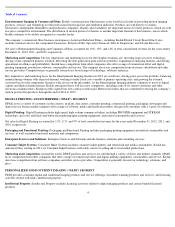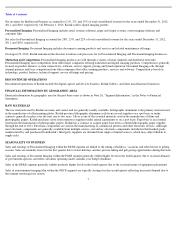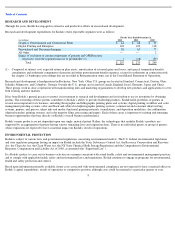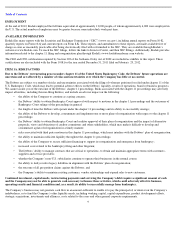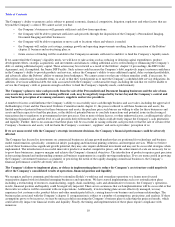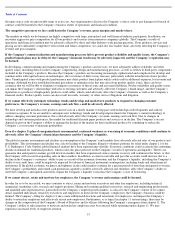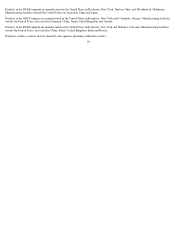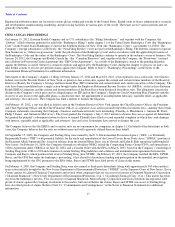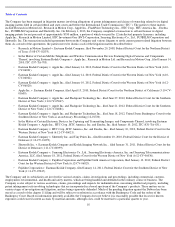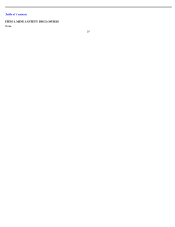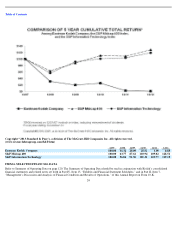Kodak 2012 Annual Report Download - page 17
Download and view the complete annual report
Please find page 17 of the 2012 Kodak annual report below. You can navigate through the pages in the report by either clicking on the pages listed below, or by using the keyword search tool below to find specific information within the annual report.
Table of Contents
source suppliers on favorable terms or at all. If any of these risks were to be realized, and assuming alternative third party relationships could not
be established, we could experience interruptions in supply or increases in costs that might result in the Company’s inability to meet customer
demand for the Company’s products, damage to the Company’s relationships with the Company’s customers, and reduced market share, all of
which could adversely affect the Company’s results of operations and financial condition.
Business disruptions could seriously harm our future revenue and financial condition and increase our costs and expenses.
Our worldwide operations could be subject to earthquakes, power shortages, telecommunications failures, cyber attacks, terrorism, water
shortages, tsunamis, floods, hurricanes, typhoons, fires, extreme weather conditions, medical epidemics, political or economic instability, and
other natural or manmade disasters or business interruptions, for which we are predominantly self insured. The occurrence of any of these
business disruptions could seriously harm our revenue and financial condition and increase our costs and expenses. In addition, some areas,
including parts of the east and west coasts of the United States, have previously experienced, and may experience in the future, major power
shortages and blackouts. These blackouts could cause disruptions to our operations or the operations of our suppliers, distributors and resellers,
or customers. The impact of these risks is greater in areas where products are manufactured at a sole or limited number of location(s), and where
the sourcing of materials is limited to a sole or limited base of suppliers since any material interruption in operations in such locations or
suppliers could impact our ability to provide a particular product or service for a period of time. These events could seriously harm our revenue
and financial condition, and increase our costs and expenses.
The Company’s sales are typically concentrated in the last four months of the fiscal year, therefore, lower than expected demand or
increases in costs during that period may have a pronounced negative effect on the Company’s results of operations.
We have typically experienced greater net sales in the fourth fiscal quarter as compared with the other three quarters. Developments, such as
lower-than-anticipated demand for the Company’
s products, an internal systems failure, increases in materials costs, or failure of or performance
problems with one of the Company’s key logistics, components supply, or manufacturing partners, could have a material adverse impact on the
Company’s financial condition and operating results, particularly if such developments occur late in the third quarter or during the fourth fiscal
quarter. Equipment and consumable sales in the commercial marketplace peak in the fourth quarter based on increased commercial print
demand. Tight credit markets that limit capital investments or a weak economy that decreases print demand could negatively impact equipment
or consumable sales. These external developments are often unpredictable and may have an adverse impact on the Company’s business and
results of operations.
If we fail to manage distribution of the Company’s products and services properly, the Company’s revenue, gross margins and earnings
could be adversely impacted.
We use a variety of different distribution methods to sell and deliver the Company’s products and services, including third party resellers and
distributors and direct and indirect sales to both enterprise accounts and customers. Successfully managing the interaction of direct and indirect
channels to various potential customer segments for the Company’s products and services is a complex process. Moreover, since each
distribution method has distinct risks and costs, the Company’
s failure to implement the most advantageous balance in the delivery model for the
Company’s products and services could adversely affect the Company’s revenue, gross margins and earnings. This has concentrated the
Company’s credit and operational risk and could result in an adverse impact on the Company’s financial performance.
We may be required to recognize additional impairments in the value of the Company’s goodwill and/or other long-lived assets, which
would increase expenses and reduce profitability.
Goodwill represents the excess of the amount we paid to acquire businesses over the fair value of their net assets at the date of the acquisition.
We test goodwill for impairment annually or whenever events occur or circumstances change that would more likely than not reduce the fair
value of a reporting unit below its carrying amount. Additionally, the Company’s other long-
lived assets are evaluated for impairments whenever
events or changes in circumstances indicate the carrying value may not be recoverable. Either of these situations may occur for various reasons
including changes in actual or expected income or cash flows. We continue to evaluate current conditions to assess whether any impairment
exists. Impairments could occur in the future if market or interest rate environments deteriorate, expected future cash flows of the Company’s
reporting units decline, or if reporting unit carrying values change materially compared with changes in respective fair values. On February 1,
2013, the Company sold its digital imaging patents. The cash flows related to the Intellectual Property goodwill reporting unit from patent
licensing activity will significantly change and the fair value of the reporting unit may be materially impacted as a result of the sale.
15


